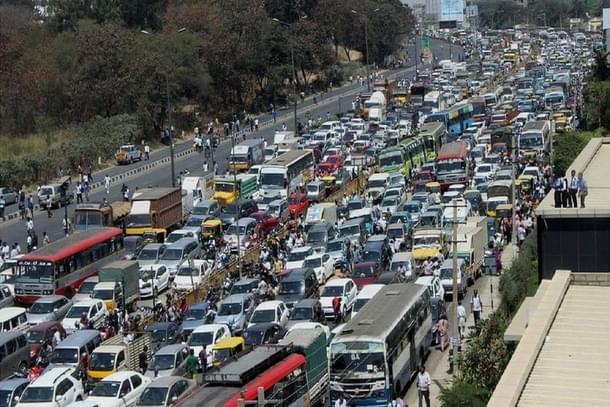News Brief
Bengaluru's Traffic Costs The City Nearly Rs 20,000 Crore Each Year: Expert Study
Abhay Rathore
Aug 07, 2023, 06:04 PM | Updated 06:08 PM IST
Save & read from anywhere!
Bookmark stories for easy access on any device or the Swarajya app.


Bengaluru, known for its thriving tech-industry and notorious traffic congestion, has suffered a staggering loss of Rs 19,725 crore per year, due to various factors related to vehicular traffic, finds a recent study.
The study, conducted by traffic expert M N Sreehari and his team, focuses on the challenges surrounding road planning, flyovers, traffic management, and the infrastructural deficit in Bengaluru, reported NDTV.
Despite having 60 fully-functional fly-overs in the city, Bengaluru has incurred a significant loss for road users.
This loss is attributed to delays, congestion, stoppages at signals, interference of slow-moving vehicles with fast-moving ones, fuel loss, occupants' time loss, and other related factors.
The reports highlight that the rapid growth of employment in the IT sector has led to the development of various supporting facilities such as housing and education. Consequently, Bengaluru's population has soared to 14.5 million, with a vehicle population nearing 1.5 crore.
According to estimates, Bengaluru's area expanded significantly from 88 sqm to 985 sqm in 2023. The study suggests that the city should further expand to 1,100 sqm.
However, the growth in road length has not kept pace with the increase in vehicles and area. The report highlights that the total road length is approximately 11,000 km, which is insufficient to meet the transportation demand and the number of trips made.
The rapid population growth and job opportunities in Bengaluru have outpaced the development of infrastructure. This gap has resulted in delays, congestion, increased travel time, and significant economic losses in terms of direct and indirect costs, as stated by Sreehari and his team.
To address these challenges, Sreehari emphasises the need for radial roads, ring roads, and specific rings such as the Outer Ring Road, Peripheral Ring Road, and Satellite Town Ring Road (STRR).
Additionally, a circular route every 5 km, connected by radial roads, would be beneficial, he added. However, the construction and maintenance costs of the STRR have escalated due to issues related to land acquisition.
Experts have suggested the implementation of underground-based road systems to accommodate road traffic for the next 25 years.
The study recommends exploring underground transportation options for metros and government buses, with openings every 1-2 km, providing escape routes and ventilation, especially during emergencies.
Additionally, the study emphasises the need for the government to eliminate roadside parking, as roads should be reserved for traffic and footpaths for pedestrians. Sreehari highlights the lack of parking-free roads in Bengaluru.
The study team also advocates for an increase in mass transportation options such as metro, monorail, and high-capacity buses, while discouraging private transportation.
They also recommend the integration of artificial intelligence, robotics, and informatics through variable message systems to enhance road user experience.
To enforce traffic regulations effectively, the report suggests deploying sufficient personnel for monitoring and immediate action, in addition to camera and sensor systems.
Abhay Rathore is Staff Writer at Swarajya.





